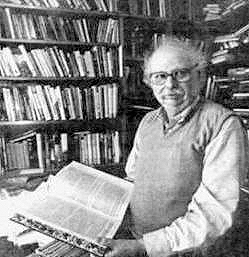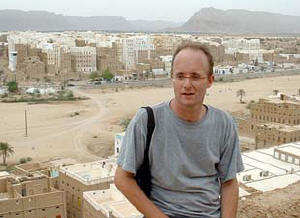
Zionism is a nationalist movement that espouses the establishment of, and support for a homeland for the Jewish people centered in the area roughly corresponding to the Land of Israel, the region of Palestine, Canaan, or the Holy Land, on the basis of a long Jewish connection and attachment to that land.

Israel Shahak was an Israeli professor of organic chemistry at the Hebrew University of Jerusalem, a Holocaust survivor, an intellectual of liberal political bent, and a civil-rights advocate and activist on behalf of both Jews and Gentiles (non-Jews). For twenty years, he headed the Israeli League for Human and Civil Rights (1970–90) and was a public critic of the policies of the governments of Israel. As a public intellectual, Shahak's works about Judaism proved controversial, especially the book Jewish History, Jewish Religion: The Weight of Three Thousand Years (1994).

Mohammed Amin al-Husseini was a Palestinian Arab nationalist and Muslim leader in Mandatory Palestine.
Zionist entity, Zionist regime, and Zionist enemy are interchangeable pejorative terms used by Arabs and Muslims in reference to the State of Israel. Many commentators believe that the terms are used to de-legitimize Israeli sovereignty by attempting to push a narrative in which Israel is nothing more than a settler-colonial project. The terms also pin an alternative definition to Zionism, primarily through the implication that Zionism is an ideology centred on racial discrimination.

The Lebanese Civil War was a multifaceted armed conflict that took place from 1975 to 1990. It resulted in an estimated 120,000 fatalities and an exodus of almost one million people from Lebanon.

Saad Haddad was the founder and head of the South Lebanon Army (SLA) during the Lebanese Civil War. For years Haddad was closely collaborating and receiving arms and political support from Israel against Lebanese government forces, Hezbollah, and the Syrian Army. Haddad died of cancer in his house in Marjayoun.

The 1978 South Lebanon conflict began after Israel invaded southern Lebanon up to the Litani River in March 1978, in response to the Coastal Road massacre near Tel Aviv by Lebanon-based Palestinian militants. The conflict resulted in the deaths of 1,100–2,000 Lebanese and Palestinians, 20 Israelis, and the internal displacement of 100,000 to 250,000 people in Lebanon. The Israel Defense Forces gained a military victory against the Palestine Liberation Organization as the latter was forced to withdraw from southern Lebanon, preventing it from launching attacks on Israel from across its land border with Lebanon. In response to the outbreak of hostilities, the United Nations Security Council adopted Resolution 425 and Resolution 426 on 19 March 1978, which called on Israel to immediately withdraw its troops from Lebanon and established the United Nations Interim Force in Lebanon (UNIFIL).
The Arab League was formed in Cairo on 22 March 1945 with six members: Egypt, Iraq, Transjordan, Lebanon, Saudi Arabia, and Syria. Yemen joined on 5 May 1945. Since its formation the Arab League has promoted the Palestinian Arab cause in the Israeli–Palestinian conflict, including by imposing the Arab League boycott of Israel. The Arab League opposed the United Nations Partition Plan for Palestine in 1947. On 15 May 1948, the then seven Arab League members coordinated an invasion of what was by then the former British Mandate, marking the start of the 1948 Arab–Israeli War.

Arab Jews is a term for Jews living in or originating from the Arab world. The term is politically contested, often by Zionists or by Jews with roots in the Arab world who prefer to be identified as Mizrahi Jews. Many left or were expelled from Arab countries in the decades following the founding of Israel in 1948, and took up residence in Israel, Western Europe, the United States and Latin America.
The Arab–Israeli conflict began in the 20th century, evolving from earlier Intercommunal violence in Mandatory Palestine. The conflict became a major international issue with the birth of Israel in 1948. The Arab–Israeli conflict has resulted in at least five major wars and a number of minor conflicts. It has also been the source of two major Palestinian uprisings (intifadas).

Blaming the Victims: Spurious Scholarship and the Palestinian Question, is a collection of essays, co-edited by Palestinian scholar and advocate Edward Said and journalist and author Christopher Hitchens, published by Verso Books in 1988. It contains essays by Said and Hitchens as well as other prominent advocates and activists including Ibrahim Abu-Lughod, Janet L. Abu-Lughod, Noam Chomsky, Norman G. Finkelstein, Rashid Khalidi.

During the 1948 Palestine War in which the State of Israel was established, around 700,000 Palestinian Arabs or 85% of the total population of the territory Israel captured fled or were expelled from their homes by Israeli forces. The causes for this mass displacement is a matter of great controversy among historians, journalists, and commentators.

The intercommunal conflict in Mandatory Palestine was the civil, political and armed struggle between Palestinian Arabs and Jewish Yishuv during the British rule in Mandatory Palestine, beginning from the violent spillover of the Franco-Syrian War in 1920 and until the onset of the 1948 Arab–Israeli War.
This timeline of anti-Zionism chronicles the history of anti-Zionism, including events in the history of anti-Zionist thought.

Jonathan Cook is a British writer and a freelance journalist based in Nazareth, Israel, who writes about the Israeli–Palestinian conflict. He writes a regular column for The National of Abu Dhabi and Middle East Eye.
The following is a list of works by Israel Shahak.

The 1948 Palestine war was fought in the territory of what had been, at the start of the war, British-ruled Mandatory Palestine. It is known in Israel as the War of Independence and in Arabic as a central component of the Nakba. It is the first war of the Israeli–Palestinian conflict and the broader Arab–Israeli conflict. During the war, the British terminated the Mandate and withdrew, ending a period of rule which began in 1917, during the First World War. Beforehand, the area had been part of the Ottoman Empire. By the end of the war, the State of Israel had been established by the Jews of the Yishuv, its creation having been declared on the last day of the Mandate. A demographic transformation had occurred in the area which became Israel, with the displacement of around 700,000 Palestinian Arabs and the destruction of most of their urban areas. Many Palestinian Arabs ended up stateless, displaced either to the Palestinian territories captured by Egypt and Jordan or to the surrounding Arab states; many of them, as well as their descendants, remain stateless and in refugee camps.

Greater Palestine is an irredentist notion used by some Palestinian nationalists seeking to establish a Palestinian nation state over the whole of former Mandatory Palestine.

The Palestinian enclaves are areas in the West Bank designated for Palestinians under a variety of US and Israeli-led proposals to end the Israeli-Palestinian conflict. The enclaves are often compared to the nominally self-governing black homelands created in apartheid-era South Africa, and are therefore referred to as bantustans. They have been referred to figuratively as the Palestinian archipelago, among other terms.
The Palestine Research Center (PRC) was an institute established in Beirut in 1965 to gather, conserve and analyse books and materials relating to Palestine, its culture and modern history, and to the political struggles of the Palestinian people. It suffered damage from several attacks before a car bomb placed by an Israel proxy terrorist group, the Front for the Liberation of Lebanon from Foreigners destroyed the building in 1983. It was under diplomatic protection.














